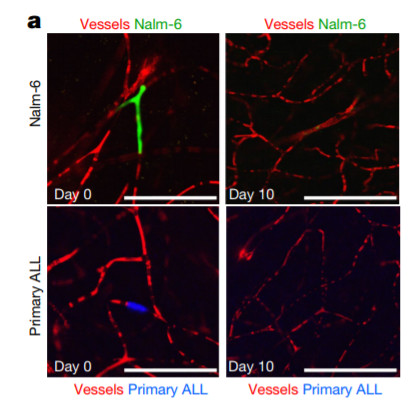Nature: Cancer cells can invade the central nervous system in this way.
July 25, 2018 Source: Academic Jingwei
Window._bd_share_config={ "common":{ "bdSnsKey":{ },"bdText":"","bdMini":"2","bdMiniList":false,"bdPic":"","bdStyle":" 0","bdSize":"16"},"share":{ }};with(document)0[(getElementsByTagName('head')[0]||body).appendChild(createElement('script')) .src='http://bdimg.share.baidu.com/static/api/js/share.js?v=89860593.js?cdnversion='+~(-new Date()/36e5)];In acute leukemia, cancer cells can break through the blood-brain barrier and invade the brain. How is this done?
In the progression of cancer, there is an unsolved mystery that has plagued scientists: our central nervous system is protected by a structure called the “blood-brain barrier†that prevents harmful substances in the blood circulation from causing damage to the brain and spinal cord. hurt. But in acute leukemia, cancer cells break through this seemingly insurmountable barrier and invade the brain. How is this done?
Recently, scientists from the Duke Cancer Institute in the United States unexpectedly discovered the mechanism of cancer cell invasion. In the past, we all speculated that these sputum cells would find wounds on the blood-brain barrier. Or simply destroy the blood-brain barrier and enter the brain. However, the study found that these cells have taken advantage of the blood vessels in the human body and swayed into the central nervous system! The study was published in the latest issue of Nature.
In this study, the researchers initially focused on the direct attack of cancer cells on the blood-brain barrier. Over the past 10 years, we have spent a lot of effort to find the mechanism by which cancer cells penetrate this barrier, but they all end in failure. Is this because our microscopic observation technology is still not enough?
To assess this possibility, the scientists in the study tried a new observation technique. They first labeled the cancer cells with fluorescence and injected them into the blood vessels of the mice. In this way, as long as you observe the movie continuously, you can know where these cancer cells invade.

â–² Cancer cells did not invade the blood-brain barrier by pre-conceived means (Source: Nature)
But the study unexpectedly suffered setbacks. Although we can clearly see the distribution of these cancer cells in the body, we have never found the moment when cancer cells penetrate the blood-brain barrier.
“This is very confusing,†said Professor Dorothy Sipkins, the author of the study. “This process should be traceable, but why is it so difficult to observe how cancer cells invade the blood-brain barrier?â€
When the research was deadlocked, an unexpected discovery gave these researchers new ideas. Also in mouse experiments, they found a potential anti-cancer molecule that effectively prevents cancer cells from invading the brain. Subsequent studies have also confirmed that leukemia cancer cells are also safely in the bone marrow of animals under the influence of drugs. Interestingly, this anti-cancer molecule does not itself penetrate the blood-brain barrier into the brain or spinal cord. In other words, it does not kill the cancer cells in the central nervous system, but prevents the cancer cells from entering from the source.
So what mechanism is it that allows cancer cells to metastasize from the bone marrow to the central nervous system? “When we dissected the spine around the spinal cord, we saw a strange phenomenon: leukemia cells look as if they are passing through the passageway and go directly into the spinal cord,†adds Professor Sipkins.
This channel is a type of capillaries called emissary veins that connect the bone marrow at one end and the blood-brain barrier to the subarachnoid space at the other end. The capillaries of this capillaries express a molecule called fibronectin, which can be used by cancer cells of leukemia to rely on the integrins expressed in themselves to invade the central nervous system along these blood vessels.
“This is a completely unexpected road to invasion,†Professor Sipkins said. In this way, past patient data, anatomical results, and molecular mechanisms are perfectly linked together, and understanding how cancer cells invade the central nervous system is expected to bring new treatments to the disease. For example, a drug called idelalisib is expected to be effective in treating cancer cell invasion. Currently, it has been approved by the US FDA to treat other types of leukemia. And this discovery, let us see the hope of the new use of old drugs.

â–² Graphic of this study (Source: Alisa Weigandt for Duke Health)
We are grateful to the findings of these researchers and look forward to these new results to expand the field of existing therapies and help patients.
Reference materials:
[1] Leukaemia hijacks a neural mechanism to invade the central nervous system
[2] Researchers solve mystery of how ALL enters the central nervous system
Earhook Hearing Aid
Earhook Hearing Aid
Shenzhen Sunshine Technology Co.,Ltd , https://www.shenzhenyatwin.com